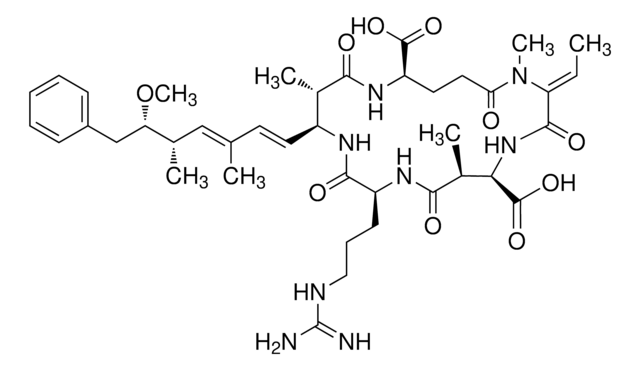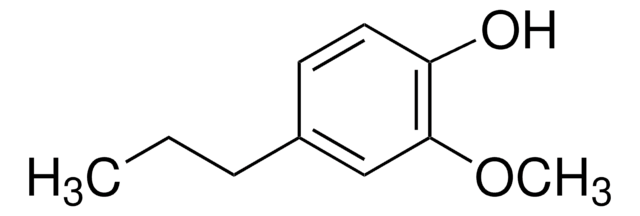W246808
Isoeugenol
mixture of cis and trans, 99%, FG
Synonyme(s) :
2-Methoxy-4-propenylphenol
About This Item
Produits recommandés
Source biologique
synthetic
Niveau de qualité
Qualité
FG
Halal
Kosher
Agence
meets purity specifications of JECFA
Conformité réglementaire
EU Regulation 1334/2008 & 178/2002
FDA 21 CFR 117
FDA 21 CFR 172.515
Densité de vapeur
>1 (vs air)
Pression de vapeur
<0.01 mmHg ( 20 °C)
Essai
99%
Indice de réfraction
n20/D 1.575 (lit.)
pb
132 °C/10 mmHg (lit.)
Densité
1.082 g/mL at 25 °C
Application(s)
flavors and fragrances
Documentation
see Safety & Documentation for available documents
Allergène alimentaire
no known allergens
Propriétés organoleptiques
clove; woody; spicy; sweet
Chaîne SMILES
OC1=CC=C(/C=C/C)C=C1OC
InChI
1S/C10H12O2/c1-3-4-8-5-6-9(11)10(7-8)12-2/h3-7,11H,1-2H3/b4-3+
Clé InChI
BJIOGJUNALELMI-ONEGZZNKSA-N
Informations sur le gène
rat ... Ar(24208)
Vous recherchez des produits similaires ? Visite Guide de comparaison des produits
Mention d'avertissement
Warning
Mentions de danger
Conseils de prudence
Classification des risques
Acute Tox. 4 Dermal - Acute Tox. 4 Oral - Eye Irrit. 2 - Skin Irrit. 2 - Skin Sens. 1A - STOT SE 3
Organes cibles
Respiratory system
Code de la classe de stockage
11 - Combustible Solids
Classe de danger pour l'eau (WGK)
WGK 2
Point d'éclair (°F)
233.6 °F - closed cup
Point d'éclair (°C)
112 °C - closed cup
Équipement de protection individuelle
dust mask type N95 (US), Eyeshields, Faceshields, Gloves
Faites votre choix parmi les versions les plus récentes :
Déjà en possession de ce produit ?
Retrouvez la documentation relative aux produits que vous avez récemment achetés dans la Bibliothèque de documents.
Les clients ont également consulté
Notre équipe de scientifiques dispose d'une expérience dans tous les secteurs de la recherche, notamment en sciences de la vie, science des matériaux, synthèse chimique, chromatographie, analyse et dans de nombreux autres domaines..
Contacter notre Service technique












